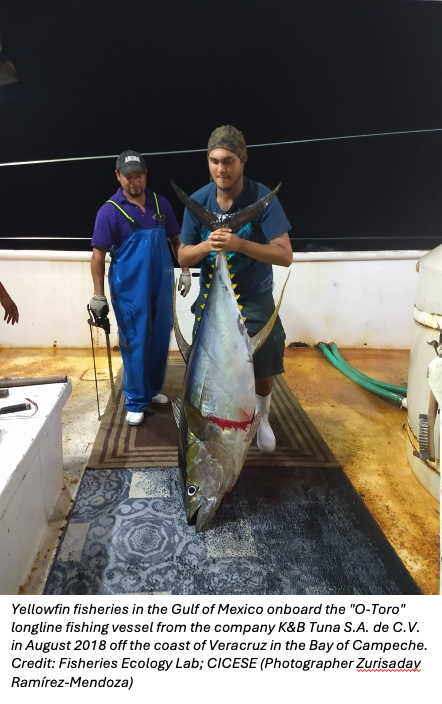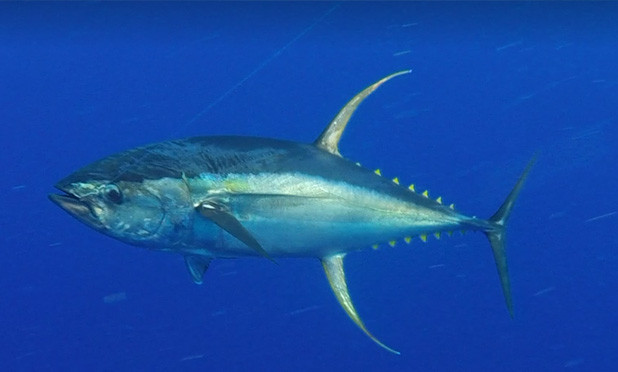 As any good angler knows, large pelagic fish are hard to track, and getting a grasp of their populations and the areas or habitats they prefer is even harder. In a new study released this month in Scientific Reports, researchers combine an unprecedented and extensive data set of seven years of long-line catch data for the southern Gulf of Mexico with environmental data and statistical analysis to generate habitat suitability models, which provide a prediction of the oceanographic conditions favored by yellowfin tuna. Yellowfin tuna in the Gulf of Mexico is a very popular fishery in the United States and Mexico, supporting ~25% of the species’ annual global catch.
As any good angler knows, large pelagic fish are hard to track, and getting a grasp of their populations and the areas or habitats they prefer is even harder. In a new study released this month in Scientific Reports, researchers combine an unprecedented and extensive data set of seven years of long-line catch data for the southern Gulf of Mexico with environmental data and statistical analysis to generate habitat suitability models, which provide a prediction of the oceanographic conditions favored by yellowfin tuna. Yellowfin tuna in the Gulf of Mexico is a very popular fishery in the United States and Mexico, supporting ~25% of the species’ annual global catch.
Their study focused on mesoscale features, which are circulation structures spanning a few hundred kilometers. Researchers found that in the oceanic waters of the Gulf, yellowfin tuna preferred areas along the edges of anticyclonic eddies, which rotate clockwise, measure 100-200 km and are about 1000 km deep. These structures break off from the Loop Current when it enters the Gulf of Mexico through the Yucatan Channel and exits through the Florida Straits. Habitat suitability was also high between clockwise and anticlockwise mesoscale circulation features when they were close to each other. The margins of anticyclonic eddies bring nutrients to the surface, supporting plankton and congregating prey throughout the water column. The vertical shear along the edges of eddies may also reduce the drag and expended energy that tuna require when diving for that prey. Thus, the results highlight the yellowfin tuna’s affinity for anticyclonic eddies during their seasonal migrations within the Gulf of Mexico.
Habitat suitability was shown to vary seasonally; it was predicted to be higher in the central and northern Gulf of Mexico in winter and spring and higher in the southern Gulf during the summer and fall. This pattern likely reflects the seasonal migration of yellowfin tuna within the Gulf of Mexico, as documented in previous studies. Also, in the summer months, when the surface waters of the Gulf are very warm, habitat suitability is higher in eddies that rotate counterclockwise; these structures are more productive, providing greater prey availability and are cooler below the surface than anticyclonic eddies.
Dr. Sharon Herzka, associate professor at the University of Texas Marine Science Institute and co-author, remarked, "Our research underscores the importance of understanding the dynamic nature of oceanic conditions when predicting yellowfin tuna distribution. By understanding the preferred habitat of tuna relative to mesoscale features and seasons across space and time, we can develop more effective fisheries management strategies to ensure the sustainability of this valuable fishery."
The results of this study support continued and more effective management of the fishery. The implications of this research extend beyond scientific inquiry, offering a deep understanding of the main drivers of the yellowfin tuna distribution for fisheries management in Mexico and the United States. By incorporating dynamic environmental data into management practices, policymakers can better protect yellowfin tuna populations while supporting the livelihoods of anglers. As the temperature and current patterns continue to change in the future due to natural processes and climate change, the information on hot spots and habitat suitability will also help predict the fate of this valuable fishery.
Dr. Herzka is joined by the lead author Zurisaday Ramírez‑Mendoza, Ph.D. student from Centro de Investigación Científica y de Educación Superior de Ensenada (CICESE), Oscar Sosa‑Nishizaki and Mario Pardo from CICESE, Michel Dreyfus‑León from Mexico’s National Program for the Use and Protection of Tuna and Dolphins, David Wells and Jay Rooker from Texas A&M University at Galveston, and Brett Falterman from Fisheries Research Support LLC. Support for this work was provided by the Mexican National Council for Science and Technology, Mexican Ministry of Energy.









